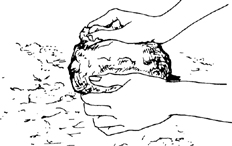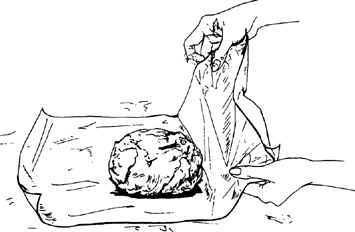Mastering the Art of French Cooking, Volume 2 (51 page)
Read Mastering the Art of French Cooking, Volume 2 Online
Authors: Julia Child

You should have a heavy pin with a rolling surface at least 14 inches long; 16 to 18 inches is preferable. You will probably have to try a restaurant supply house to find a decent pin, because a broom handle is certainly far more efficient than the ridiculous toy (A) that passes for a rolling pin in many household supply departments. The French pastry chef’s pin (B) is of polished boxwood, 18 inches long and 2 inches in diameter; stores selling Italian cooking equipment often have a similar model of lighter wood.
The French Tutove pin (C) is sometimes available in import stores; its cannellated surface is designed especially for distributing the butter evenly throughout the dough when you roll puff pastry or croissants. The American-made pastry-chef’s pin (D) is of polished hardwood and has ball-bearing handles; this fine, heavy pin is usually available only in restaurant supply houses.
FLOUR NOTE
The following recipes call for a mixture of all-purpose and cake flour, a combination always available and one that is used by many pastry chefs in this country. The nearest American approximation of French household pastry flour, “type 55,” that we have discovered is a mixture of ⅔ unbleached
pastry flour (not to be confused with cake flour) and ⅓ unbleached all-purpose flour. This combination has a lower gluten strength than the all-purpose and cake mixture, and it is easier and faster to handle because it needs shorter rest periods. However, unbleached flours, and especially unbleached pastry flour, are not to be found in most retail markets. Actually the cake and all-purpose combination, though slower to work with than either French flour or its American approximation, produces the lightest and
puffiest pastry. (You may substitute French household flour or the ⅓–⅔ pastry flour and all-purpose flour combination in the following recipe.)
KEEPING COOL AND RELAXED
You will have very little trouble with puff pastry when you remember that you must keep the dough cold and that you must let it have the rest periods it needs.
Because of its high butter content, puff-pastry dough begins to soften as soon as you remove it from the refrigerator, just as butter softens. When you leave it too long at room temperature it becomes limp, sticky, and utterly impossible to work with until you refrigerate it again. Thus, if at any point your dough becomes limp and soft, stop where you are, refrigerate the dough for 30 minutes, then continue. Do the same if the dough retracts after rolling, or if it turns rubbery and refuses to extend itself; this means that the gluten in the dough is over-activated from having been rolled out, and the way to calm it down is to stop rolling and let the dough relax in the refrigerator for an hour or two. Most of the troubles most people have with puff pastry spring from unchilled dough and over-activated gluten.

PÂTE DEMI-FEUILLETÉE
[Simple Puff Pastry—Flaky Pastry—Mock Puff Pastry]
For the many recipes like turnovers, toppings for meat pies, meats baked in a crust, appetizers, and so forth where you want a flaky, light dough,
demi-feuilletée
can be ready for baking in 3 to 4 hours. The pastry consists of an initial dough made of flour, water, salt, and a little oil, which acts as a tenderizer; this is pushed out into a 16-inch rectangle that is spread with softened butter. Then the rectangle is folded into 3, making a sandwich that has 3 dough layers and 2 butter layers. Rolled out and folded again 3 more times, as sketched in the recipe, the layers build up in geometric progression to make 72 layers of butter after the fourth fold. When the pastry finally goes into the oven, each of the many layers of dough puffs up between the layers of butter and the pastry bakes into a light, airy delight to both eye and tongue.
For about 1 pound of flour, making 2½ pounds of dough, enough for 2 of the 6- by 16-inch covered
entrée pastries
, or about 3 dozen of the
cornets, or horns
1)
La détrempe—the dough mixture
2¾ cups all-purpose flour and ¾ cup plain bleached cake flour, measured by scooping dry-measure cups into flour and leveling off with straight-edged knife
A 3- to 4-quart mixing bowl
A rubber spatula
A ½-cup measure to reserve flour for Step 2
¼ cup tasteless salad oil
2 tsp salt
1 cup iced water, plus a tablespoon or so more if needed
A 2-foot sheet of waxed paper
A plastic bag
Blend the 2 flours together in the mixing bowl with the rubber spatula. Remove ½ cup and reserve for Step 2.
Stir the oil into the flour and
mix thoroughly with rubber spatula
—you could use an electric mixer for this, but it hardly seems worthwhile. Then stir in the salt and the water, cutting and pressing ingredients firmly into a mass with spatula and then with the cupped fingers of one hand. Lift massed parts of dough out of bowl and place on pastry marble or board. Sprinkle unmassed bits of flour with drops of water in bowl; press together and add to dough.
Press dough firmly and rapidly into a cushion shape |
|
| If you are in a terrible rush you can complete the next 2 steps now, but the dough will be easier to handle if you sprinkle it lightly with flour, |





